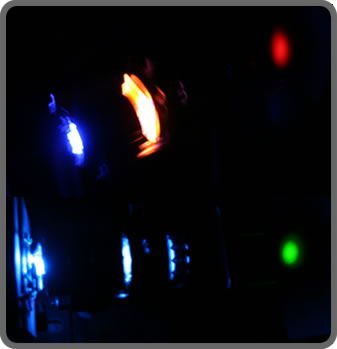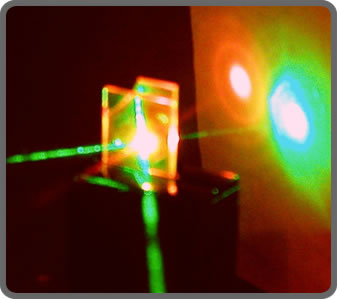|
The Research
The
aim of this four-year Basic Technology Research Programme
is to develop a new generation of micron sized tunable
coherent light sources, i.e. continuously tunable, multi-wavelength
lasers, based on ordered organic chiral structures. The
size of these lasers would be less than the dimensions
of the human hair, i.e. 10µm×10µm, and
the spectral range will be from the near ultra-violet
to the near infra-red. Such lasers do not yet exist although
there are small single wavelength output semiconductor
lasers being developed and produced using expensive Si-based
solid state technology. Here the vision and technologies
are different. All organic lasers will have many advantages
ranging from low-cost, ease of production, infinite wavelength
tunability (in the visible spectrum), as well as micron
length scale size.

Fig.2:
Red & green emission in photonic bandgap devices.
This
Basic Technology Research Programme will produce a generic
technology base that will be adaptable to a broad range
of research problems and challenges spanning the multidisciplinary
interests of the different research councils, (primarily
EPSRC, BBSRC, and MRC). It will also lead to a UK manufacturing
capability (e.g. in materials, optoelectronic devices,
and spectroscopy).
|
 |

Fig.1:
A liquid crystal laser (red), being optically
pumped by a Nd:YAG laser (green).
Our
lasers will be based on two essential thin film elements:
1) a light emitting organic moiety, excited optically
or electrically, incorporated in 2) a tunable 1-, 2- or
3- dimensional Photonic Bandgap Organic Structure (PBOS).
Thus the possibility exists of a multi-wavelength tunable
source that may emit in 1-, 2- or 3-dimensions simultaneously
with the PBOS providing a distributed feed-back (DFB)
that allows the laser cavity (resonator) to be formed
without mirrors. The PBOS structure selects the particular
lasing mode with a well-defined wavelength, direction
and the large far field coherence area. The key advantage
of the PBOS systems is that they are based on Soft Organic
Matter (eg: chiral liquid crystals or functionalised polymers,
or indeed bio-polymers) in which the bandgap can be readily
tuned by external agents, ie: electric and magnetic fields,
UV light, temperature, mechanical stress, chemical species
etc., thus changing the wavelength output and direction
of the laser beam. It is this tunability coupled with
the micron size and the potential ease of production that
will open up new opportunities for applications in different
areas of medicine (dermatology, introscopy, lab in a capsule,
diabetes detection, etc), biology (cell recognition, DNA
and disease analyses, etc), sensing (chemical, external
field, virus, TB etc), optical micro-circuitry (all-optical
micro-circuit board, etc.), telecommunications engineering
(sources, optical switches, routers, interconnects etc.)
and displays (micro-displays, large-area polariser-free
displays, flexible devices, etc.).
|